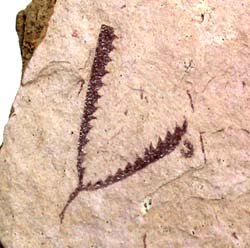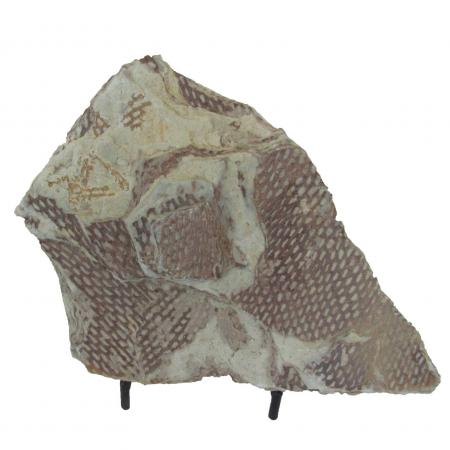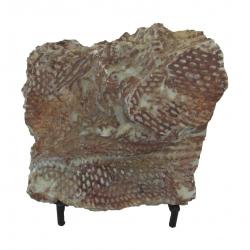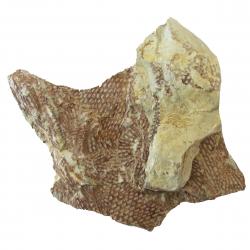Sign up for Lesson Plans, discounts & more!
Graptolites
Graptolites are a fascinating group of extinct marine organisms that thrived during the Paleozoic era. These tiny, delicate animals belonged to the Phylum Hemichordata and left behind a rich fossil record that has provided valuable insights into the evolution and development of early marine ecosystems. In this article, we will delve into the world of graptolites, exploring their origins, anatomy, diversity, and significance in the field of paleontology.
Graptolites first appeared in the Middle Cambrian period around 511 million years ago, reaching their peak diversity during the Silurian period, approximately 440 million years ago. They finally went extinct during the Late Devonian period, around 376 million years ago. Despite their relatively short existence in geological terms, graptolites are considered as one of the most important groups of index fossils due to their rapid evolution and widespread distribution.
What did Graptolites look like?
Structurally, graptolites were colonial organisms, meaning that they lived in colonies composed of numerous individual animals called zooids. Each zooid was housed in a tubular or cup-like structure known as a theca, which provided protection. The thecae were linked together by a common tube, the rhabdosome, forming complex arrangements that resembled long chains or branches.
Graptolite colonies had a variety of shapes and sizes, ranging from simple, unbranched forms called monograptids to more complex branched forms known as dendrograptids. The appearance and arrangement of thecae within a colony were key characteristics used to classify and identify different species.
One of the most remarkable features of graptolites is their ability to secrete organic material, forming a unique, chitinous structure known as a graptolite periderm. This periderm provided rigidity to the colony and played a role in the fossilization process, contributing to the remarkable preservation of graptolite fossils.

How did Graptolites eat?
Graptolites were filter-feeders and their colonies were typically planktonic, floating freely in the ocean currents. They used a specialized feeding structure called a lophophore, which consisted of tentacles lined with cilia that helped capture and transport food particles to their mouths. This method of feeding allowed graptolites to exploit available food resources efficiently.

The diversity of graptolite species is staggering, with thousands of known species described to date. The different types of colonies, thecae shapes, and arrangements allowed graptolites to occupy a range of marine habitats, including open ocean environments, shallow seas, and even freshwater bodies.
Graptolites were also important components of marine ecosystems, serving as a food source for various organisms, including trilobites, benthic organisms, and other suspension feeders. Their extinction had an impact on the trophic dynamics of Paleozoic ecosystems, leading to changes in predator-prey relationships and the subsequent rise of new groups.
Graptolite fossils are abundant worldwide and can be found in various sedimentary rocks, most commonly in shales and mudstones. Their delicate nature often requires careful extraction techniques and preservation methods to obtain complete and detailed specimens for study.
One of the most iconic graptolite-bearing rocks is the famous Llandoverian shale, which extends across much of Wales, England, and other parts of Europe. These shales have provided scientists with a wealth of graptolite fossils, helping reconstruct the evolutionary history and paleoecology of these fascinating organisms.
- The Llandoverian shale is characterized by its dark coloration, often ranging from gray to black, reflecting the high organic content of the sediment. Its shale layers are frequently interbedded with limestone and siltstone, forming a complex stratigraphic sequence that further contributes to the diversity of fossilized organisms found in these rocks.
- The geological significance of the Llandoverian shale extends beyond its fossiliferous nature. It serves as an important marker horizon in sequence stratigraphy, aiding in correlation and dating of other rock formations within the Lower Silurian period. Additionally, the Llandoverian shale has played a crucial role in refining the geologic timescale and establishing biostratigraphic zones.
- To access the fossiliferous layers of the Llandoverian shale, paleontologists and collectors often employ careful excavation techniques, as the rocks can be quite brittle and prone to crumbling. Preservation of the delicate graptolite fossils requires meticulous preparation and stabilization, ensuring that specimens are protected and can be studied in detail.
- The Llandoverian shale has been a key site for paleontologists and researchers interested in studying the Paleozoic marine ecosystem. Graptolite fossils from this formation have provided valuable insights into the evolutionary patterns and paleoecology of these ancient organisms, as well as the broader ecological dynamics of the time.
When studying graptolite fossils, scientists mainly focus on the shape, size, and arrangement of thecae within a colony, as well as the presence and morphology of different reproductive structures. Combining these features allows for precise taxonomic classification and identification.
Graptolite fossils have been key in defining and correlating different geologic time periods, as they often display rapid and distinct evolutionary changes. By examining the variations in graptolite species through time, researchers can establish reliable stratigraphic boundaries and refine the geologic timescale.
In addition to their importance as index fossils, graptolites also provide crucial information about paleoclimates and paleoenvironments. For instance, some species of graptolites were restricted to specific water depths, allowing scientists to infer past sea level fluctuations or changes in oceanic circulation patterns.
Graptolite evolution was punctuated by several major extinction events, the most significant being the Late Ordovician mass extinction, which wiped out approximately 85% of all species. This event challenged the survival of graptolites, leading to the extinction of many lineages and the subsequent diversification of new forms.
Due to their rapid evolution and abundance in the fossil record, graptolites have become a focal point for studying patterns of biodiversity, speciation, and extinction during the Paleozoic era. They help illustrate the evolutionary mechanisms and responses of marine organisms to environmental changes over millions of years.
Paleontologists have also used graptolites to study the early evolution of other marine organisms. For example, the study of graptolite reproductive structures has shed light on the origin and development of some modern marine invertebrates, providing insights into the ancestry of living organisms.
Graptolites have mesmerized collectors and fossil enthusiasts for centuries. Their intricate beauty, delicate preservation, and historical significance have made them highly sought-after specimens in the world of paleontology. Many museums and private collections proudly display remarkable graptolite fossils as a testament to the Earth's ancient inhabitants.
In recent years, technological advancements, such as high-resolution imaging techniques and computer reconstructions, have expanded our understanding of graptolite anatomy, allowing for detailed investigations of their internal structures and growth patterns. These techniques have revealed hidden complexities within graptolite colonies, providing new avenues for future research.
The study of graptolites is a truly interdisciplinary endeavor, involving paleontologists, stratigraphers, paleoclimatologists, and evolutionary biologists. The collaboration of these fields has advanced our knowledge of graptolite biology, their ecological roles, and their response to environmental changes.
While graptolites are extinct and have no direct descendants in today's oceans, their legacy lives on in our understanding of ancient marine life. They are remarkable organisms that have provided profound insights into the history of life on Earth, helping us unravel the mysteries of the past and appreciate the intricate web of life that preceded us.
In conclusion, graptolites were captivating marine organisms that flourished for around 135 million years during the Paleozoic era. Their colonial structure, rapid evolution, and prolific fossil record make them an invaluable resource for understanding Earth's ancient oceans. Exploring the diversity, anatomy, and paleoecology of graptolites allows us to piece together the puzzle of life's development and evolution in Earth's distant past.


Find specimens of Graptolites for sale at our sister site Fossilicious.com
Check out some of the Educational Materials for sale on our sister site fossilicious.com.

interested in more? If so, you may want to check out our other sites:
fossilicious.com - Our online fossil and mineral rock shop.
rocksandminerals4u.com - An educational site about rocks, minerals, and geology.
Geologic Time Geologic Time Line
Cenozoic Era
Quaternary
Neogene
Paleogene
Mesozoic Era
Cretaceous
Jurassic
Triassic
Paleozoic Era
Permian
Carboniferous
Devonian
Silurian
Ordovician
Cambrian
Archean Time
Hadean Time
Teachers Resources
Activities for Education and Fun
Earth Science Lesson Plans
Activities For Kids
Fossil Lesson Plans
Fossil Activities
Education Articles
Coloring Pages
Dinosaur Coloring Pages
Montessori Materials
Geology Club
Fossil Hunting
 |
 |
 |




